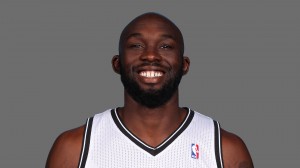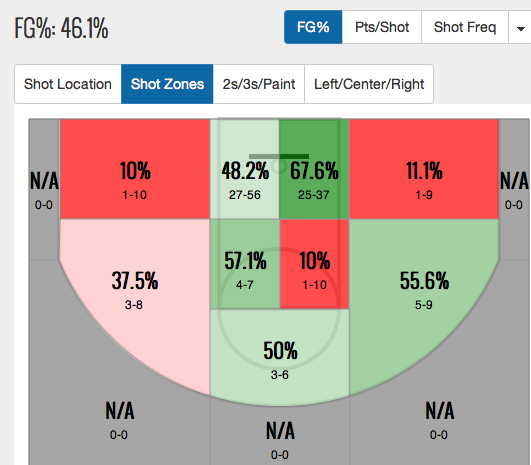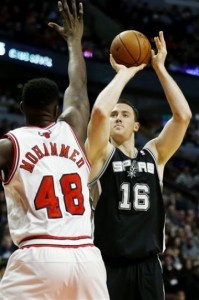 It might sound ridiculous to try to compare Aron Baynes, an undrafted reserve with four career starts, to Bill Laimbeer, a four-time All Star and NBA champion. However, the two have more in common than you would expect.
It might sound ridiculous to try to compare Aron Baynes, an undrafted reserve with four career starts, to Bill Laimbeer, a four-time All Star and NBA champion. However, the two have more in common than you would expect.
Before Laimbeer became the ringleader for the Pistons’ Bad Boys and a namesake for a Super Nintendo videogame, he was an afterthought.
Sandwiched in the draft between two players who never appeared in the NBA, Laimbeer – the 65th overall pick in 1979 – was forced to start his professional career in Italy for developmental purposes.
His limitations were obvious: forgettable leaping ability, slow legs in transition and – most glaringly – a mere 6.4 points and 5.5 rebounds per game in his senior year at Notre Dame. Still, at nearly seven feet tall and 250 pounds, Laimbeer was a physical mammoth, enabling him to eventually find a place in the league under the typecast of a “bruiser.”
Nearly every team has a bruiser in today’s NBA. Even as the league has veered away from the hard fouls of bully ball, physical reserves have remained crucial in the rare moments when teams need to slow down elite big men or deliver message fouls to opposing stars.
As a result, bruisers have become the NBA’s most situational and limited role player: lefty specialists of basketball, if you will.
Most bruisers find their niche and embrace its simplicity. Reggie Evans, for example, has played for seven teams in 12 NBA seasons and has pedestrian career averages of 4.1 points and 7.2 rebounds. At 6-8, he is undersized for a big man and he’s never blocked more than 16 shots in an entire season. 
For a frame of reference, Andrea Bargnani – whom no one would ever accuse of playing defense – had more blocks in 2009-2010 than Evans has had in his entire career. Still, Evans continues to make a living because he is willing to do a team’s dirty work and get rough.
It might be surprising to learn that Laimbeer was only slightly more versatile than Evans for most of his career. Unlike Evans, however, Laimbeer eventually developed out of his one-dimensional game and became one of the league’s most dangerous offensive weapons.
History remembers Laimbeer’s offensive versatility fondly; He was one of the league’s first stretch big men, netting more than 200 3-pointers in his career. In truth, Laimbeer was incredibly limited for much of his career. He never attempted more than 21 threes in a season until the age of 30 and shot above the league average from deep in just three of his 14 seasons.
Still, because Laimbeer’s offensive game expanded at the outset of the Pistons’ first championship run, fans 25 years later remember him as a perennial floor spacer.
Strength is one of the few assets that all players maintain as they age. So as Laimbeer developed his offensive touch in his late 20s, he suffered no discernible regressions on defense in terms of physical presence around the rim.
Look around the league today and it’s increasingly clear that Laimbeer’s game has yet to be mimicked by anyone. While stretch big men are more present than ever, very few – if any – supplement their perimeter shooting with interior defensive dependability.
That’s a large reason why Channing Frye got $32 million from Orlando this summer despite averaging just 5.1 rebounds as Phoenix’s most effective big last season. It’s also why Chris Bosh is still regarded as a max player by most executives around the league: Big men who stretch the floor can turn a good offense into a dynamic one. While also supplying dependable interior defense, they can create matchup nightmares for opposing bigs with limited mobility.
Which brings us to Baynes, the 27-year-old restricted free agent from Australia. Baynes sat behind Tim Duncan, Tiago Splitter, Boris Diaw and Matt Bonner in the Spurs’ rotation last season, so it is understandable why he’s gone under the radar for so long.
In terms of functionality, Baynes was asked to perform the Reggie Evans role for the Spurs. No more, no less. Rebound effectively, commit hard fouls and agitate opponents of higher profile. In limited time over the past two seasons, Baynes has performed that role masterfully.
Watch Baynes go pound-for-pound with Dwight Howard in the 2013 playoffs and largely succeed. Howard was eventually ejected:
[youtube https://www.youtube.com/watch?v=JlieN3cvQyg&w=640&h=390]
What makes Baynes so intriguing, however, is that he can be so much more on the floor than what San Antonio asks him to be. He’s settled into a Reggie Evans-like role out of team necessity — not out of skill limitation.
Most obviously, Baynes’ analytic projections indicate that he could be a double-double machine. Expanded to 36 minutes, Baynes’ statistics from last season balloon to 11.8 points and 10.6 rebounds. Those are starter-quality numbers, and they barely scratch the surface of his full potential.
Baynes’ rebounding numbers are legitimately impressive, borderline elite. Over the course of the 2013-2014 regular season, Baynes ranked fourth in the entire NBA in contested rebound percentage with 49 percent of his boards coming in traffic (per NBA Stats).

Baynes also swallowed 16.6 percent of all available rebounds (rebound percentage) while on the court last season, a number identical to Laimbeer’s in both of the Pistons’ championship seasons.
Analytics identify Laimbeer (a former rebounding champ and 32nd in history in career boards) as a better defensive rebounder than Baynes but conversely state that Baynes’ offensive rebounding percentage of 13.6 percent from last season would have matched Laimbeer’s very best offensive rebounding season.
And it’s not just the rebounding. Baynes emulates Laimbeer as an interior defensive presence as well.
In the 2014 playoffs, opponents shot just 40.9 percent against Baynes at the rim. While the sample size is small, that’s a percentage on par with the NBA’s best rim protectors in the NBA. For the season, Baynes’ rim protection was on par with most centers (per NBA Stats).
Rebounding and interior rim protection are talents nearly all bruisers have. What really distinguishes Baynes from the Evans-types is his offensive versatility.
In the playoffs, Baynes averaged 0.49 points per touch of the ball, far and away the most efficient of any Spurs player. Of course, the clever passing from Tony Parker, Manu Ginobili, Diaw and company aided that number.
More tellingly on offense, Baynes also showed deft touch from the center of the floor in limited time during the regular season.
Eliminate the ill-advised shots from the sides of the hoop and Baynes’ midrange percentages are encouraging. Add the fact that he shot 19-of-21 from the free throw line last season and it is clear Baynes has a sound shooting touch.
Perhaps just a willingness to shoot from midrange makes Baynes a worthwhile project. He connected on 9-of-32 midrange catch-and-shoot opportunities in the regular season. That’s not a spectacular percentage, but keep in mind that Laimbeer also was lost from the perimeter (20-for-90) until his eighth season.
Baynes has only played parts of two seasons and has still yet to hit his prime at age 27. With proper form on his shot already in place and enough confidence to keep shooting, Baynes should be able to gradually expand his  game to the perimeter and become a deep-ball threat by the age of 30.
game to the perimeter and become a deep-ball threat by the age of 30.
You might remember Frye only started attempting and connecting on 3-pointers consistently after four full seasons of perimeter futility. Baynes still has plenty of time and reason to develop a perimeter shot.
Baynes is currently a restricted free agent. San Antonio has extended a qualifying offer for less than $1 million in hopes of retaining him. However, if a team offers him an expanded role and a contract in the range of three years for $6 million, that might prove to be too expensive for the Spurs to match.
It’s time for teams to start taking notice of the underappreciated players Gregg Popovich and R.C. Buford like. They usually turn out pretty good.
Jacob Eisenberg is a senior at Emory University in Atlanta and covers analytics within the NBA for Sheridan Hoops. Give him a follow on twitter @eisenberg43 and check out his website as well.
Good article. However your comparison between Laimbeer and Baynes is kind of off to me. Yes Laimbeer did not shoot many 3’s until the late 80’s – However his mid-range game was a FAR more integral part to his game. And he was a master, if not the grandfather of the pick and pop “pick and fade” game with the pistons guards. Yes his ability to stretch out to the 3 line, as the NBA was starting to become a more 3 point oriented league was a great weapon. But him being that far out at the top of the key (he rarely shot a 3 in the corner) was also a huge part of the Pistons defensive strategy to get him back on defense quickly to stop fast break attempts and get him set up as the team’s best rim clogger, protector.
Baynes will never be a 3 point specialist, and I highly doubt will ever be in Laimbeer’s mid-range ability class. But if he can hit his free throws, clog the paint and do some dirty work and rebound he may be a diamond in the rough. But he is also getting paid like he already is those things… And well, I cant say he has quite earned that yet. So this move can also back fire, which I say is FAR more likely than him becoming the next Bill Laimbeer. One of the team’s best all time players in its history.
wonderful issues altogether, you just won a brand new reader.
What might you suggest in regards to your submit that you just made some days in the past?
Any positive?
Also visit my blog; Odzież reklamowa tani i skuteczny gadżet,
Holley,
Just watching him play in the World Cup warm ups over the past few days for Australia backs up everything you are saying. France next.
The Spurs have a roster glut, which may gum up Baynes’ return. They signed Cotton to a training camp contract that becomes guaranteed if he makes the team. He could possibly be the 15th man which leaves no room for Baynes. However, if they sign Baynes than the Cotton invite is pointless, he can’t make the team. But this could all be solved if they get rid of Ayres nee Pendergraph, he’s not as good as Baynes. If Baynes doesn’t come back to the Spurs, I think Brown in Philly will definitely give him a look.
Sure wish the Pistons had gotten him instead of the guy they got. Looks like SvG got the wrong Aaron.
They could even have kept josh Harrelson, he was a pretty good defender and 3 point shooter already.
I watched Baynes in college and he is an absolute rock. No one could move him. Decent shooting touch too. He’s really worked on his overall game and quickness.
Kinda wish he wanted more playing time and a reunion with an old SA buddy in Brett Brown
Dag nab it! We’re trying to let the offer period go by without anyone thinking about Baynes and you have to create something like this. How much to take it down?